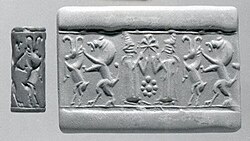Dingir⟨𒀭⟩, usuallytransliteratedDIĜIR,[1](Sumerian pronunciation:[tiŋiɾ]) is aSumerianword for 'god' or 'goddess'. Itscuneiformsign is most commonly employed as thedeterminativefor religious names and related concepts, in which case it is not pronounced and is conventionally transliterated as a superscript ⟨d⟩, e.g.dInanna.

The Sumerian cuneiform sign by itself was originally anideogramfor the Sumerian wordan('sky' or 'heaven');[2]its use was then extended to alogogramfor the worddiĝir('god' or 'goddess')[3]and the supreme deity of the Sumerian pantheonAnu,and aphonogramfor the syllable/an/.Akkadian cuneiformtook over all these uses and added to them a logographic reading for the nativeilumand from that a syllabic reading of/il/.InHittiteorthography, the syllabic value of the sign was again onlyan.
The concept of divinity in Sumerian is closely associated with the heavens, as is evident from the fact that the cuneiform sign doubles as the ideogram for 'sky', and that its original shape is the picture of a star. The eight-pointed star was a chief symbol for the goddess Inanna. The original association of 'divinity' is thus with 'bright' or 'shining' hierophanies in the sky.
Cuneiform sign
editSumerian
editThe Sumerian sign DIĜIR ⟨𒀭⟩ originated as a star-shaped ideogram indicating a god in general, or the Sumerian godAnu,the supreme father of the gods.Dingiralso meant 'sky' or 'heaven', in contrast withkiwhich meant 'earth'. Itsemesalpronunciation wasdimer.(The use ofminstead ofĝ[ŋ]was a typical phonological feature in emesal dialect.)
The plural ofdiĝircan bediĝir-diĝir,among others.
Assyrian
editTheAssyriansign DIĜIR (ASH ⟨𒀸⟩ and MAŠ ⟨𒈦⟩, see could mean:
- the Akkadian nominal stemil-meaning 'god' or 'goddess', derived from the Semiticʾil-
- the god Anum (An)
- the Akkadian wordšamû,meaning 'sky'
- the syllablesanandil(from the Akkadian word god: An or Il, or from gods with these names)
- a preposition meaning "at" or "to"
- adeterminativeindicating that the following word is the name of a god
According to one interpretation, DINGIR could also refer to a priest or priestess although there are other Akkadian wordsēnuandēntuthat are also translated priest and priestess. For example,nin-dingir(lady divine) meant a priestess who received foodstuffs at the temple of Enki in the city of Eridu.[4]
Encoding
editThe cuneiform sign was encoded inUnicode5.0 under its name AN at the code point U+1202D𒀭.
See also
editNotes
editReferences
edit- Edzard, Dietz Otto (2003).Sumerian Grammar.Handbook of Oriental Studies. Vol. 71. Atlanta: Society of Biblical Literature.ISBN1-58983-252-3.
- Hayes, John L. (2000).A Manual of Sumerian Grammar and Texts.Aids and Research Tools in Ancient Near Eastern Studies (Second revised ed.). Malibu: Undena Publications.ISBN0-89003-508-1.